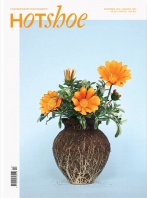

#1
“To collect photographs is to collect the world,” states Susan Sontag in her seminal book, On Photography, while for Diana Scherer, photography itself is “a way to collect”. In the production of her recent series, Nurture Studies (2010–2012), Scherer plays botanist/scientist/photographer/visual artist/collector as she researches, experiments and cultivates her ‘flower pieces’before organizing, archiving and producing photographs of her work.
The process is painstakingly slow and Scherer’s dedication to her work, both above and below ground, is evident. She started experimenting with plants and flowers, both of which are classified as flora, a couple of years ago with mixed results. “It took three years for me to discover the right working method and I had to try out lots of different flowers. Depending on the flower, I wait until the roots and the blossom are fully developed, which sometimes takes six months but other times just four. Often it doesn’t work out at all and, quite often, I found that the roots were too weak.” Scherer breaks the vase containing the plant the evening before to allow the soil and roots “to dry out a little” before photographing the ‘flower pieces’.
The series of photographs, Nurture Studies, is of cultivated plants, weeds and wild flowers that have been grown from seeds taken from her garden in the Netherlands. “The ambiguous nature of collecting intrigues me,” she says. “It involves loving attention as well as a fanatical desire to control. The collector documents and stores the object of his desire in a systematic and detached way. I also treat and present my work in an objective manner, even though working with nature has an emotional charge for me.”
Her previous bodies of work have involved high levels of control but with this series “the work creates itself”, up to a point, with Scherer manipulating “a little” and documenting the finished result. “In the work Nurture Studies, I also manipulate my tended flower pieces. Above ground, I let nature run its course. However, below the surface, by using a vase as a mould, I control the growth of the roots and the shape.” There is a tension in the beauty of the floral living sculptures where forces, such as freedom and restriction, letting go and control, produce a specimen that could also stand as a symbolic creative expression of the human situation.
Ikebana, the creative Japanese art of flower arrangement, is an inspiration, as is Bonsai, the practice of cultivating miniature trees. Ikebana has its own codes and conventions, is traditionally carried out in silence, and embodies a philosophical stance concerned with developing humanity’s closeness to nature. In these minimalist floral arrangements, the vase is an integral element in the composition. However, in Scherer’s work, there is no vase but the shape of the roots is an indexical sign of the particular container, or vase cast. As in the reproduction of sculptures, the mould contains and conceals the desired object until the cast is broken and the object is exposed. The absence of the vase thus reveals the intricate patterning of the cultivated root system, which is also a work of art. This further instills the series with notions pertaining to absence and presence. “I try to catch the moment that the plant is in its best shape,” she says. “The peak is not in my hands but in the hands of nature. Every plant has a moment when the blossom is fully grown, something that may only last for a couple of days after which it shrivels.” Transience, thus, becomes a further theme as each photograph captures and freezes what is, for Scherer, the peak of the plant’s life. That the sculptural ‘flower pieces’ are then placed against minimal backdrops and presented with simple captions only serves to highlight the constructed nature of the specimens and the role of artifice in the work.
“I’m interested in the age-old human practice of manipulating nature”, she explains. “There is a certain ambiguity that I find intriguing; the idea of loving care and, at the same time, ruthless manipulation. For example, the gardener who loves nature and nurtures the plants he desires also ruthlessly cuts, snips and manipulates them.” As to the final outcome, Scherer uses different methods of presentation aligned to the concept behind the series. “In some cases, prints are numbered and presented on walls or in showcases. In others, the end result is a book in which I organize and keep the images.” In keeping with the aesthetics of the work, the book is wrapped in a simple woodgrain-effect Japanese binding. Although the lineage of the work can be traced back to still life painting and photography as well as to illustrations from seventeenth-century botanical encyclopaedias that often depicted the root system as a further means of identification, Scherer’s work is firmly rooted in twenty-first century culture. She collects vases and uses photography as a means by which she can collect images of the plant. Both are tied to the culture of collecting, the collecting of culture and, with Nurture Studies, the cultured. And once Scherer has finished working with her ‘flower pieces’, they are returned to her garden. That Scherer has tended and reworked the root system before releasing the plant back to let nature run its own course, once again echoes the cyclical aspects of nature, of life and death, and of regeneration and degeneration.
Diana Scherer’s Nurture Studies, (2012) is published by Van Zoetendaal.
